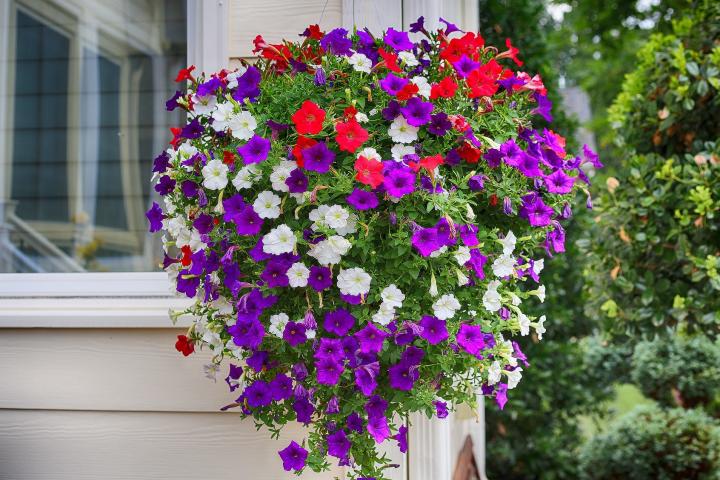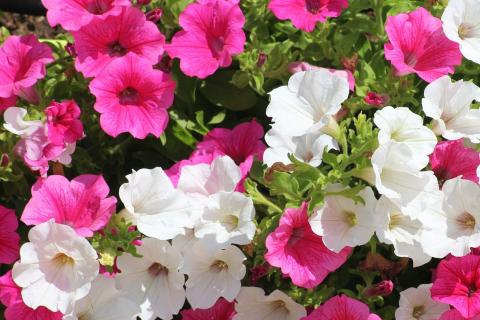Pretty petunias are one of the most popular flowers because of their exceptional blooms and long flowering period. As with most annuals, they get leggy by midsummer, so you’ll want to prune the shoots back to about half their length. See how to plant and take care of your petunias to keep them blooming.
About Petunias
Petunias are treated as annuals in most areas, but can be grown as tender perennials in Zones 9 to 11. The flowers come in many colors and patterns, and bloom from spring until frost!
These colorful annuals can really add pop to a front lawn and are often used in borders, containers, hanging baskets or even as a seasonal groundcover. Some even have a slight fragrance.
Height can vary from 6 inches to 18 inches. Spread can be from 18 inches to 4 feet.
Petunias are divided into different groups, mainly based on flower size:
- Multiflora petunias are the most durable and prolific. They have smaller but more abundant flowers and are ideal for summer bedding or in a mixed border (because they are more tolerant to wet weather).
- Grandiflora petunias have very large flowers and are best grown in containers or hanging baskets (because they are more susceptible to rain damage). These large petunias often do not fare as well in the south because they’re prone to rot during humid, hot summers.
- Floribundas: Floribundas are intermediate between the grandiflora and the multiflora groups. They are free-flowering like the multiflora varieties and produce medium-sized blooms.
- Millifloras: Milliflora petunias are much smaller than any other petunias on the market. The flowers are only 1 to 1½ inches wide, but they are prolific and last all season!
- Spreading or Trailing Petunias: These are low-growing and can spread as much as 3 to 4 feet. They form a beautiful, colorful groundcover because the flowers form along the entire length of each stem. They can be used in window boxes or hanging baskets.
When to Plant Petunias
- It’s easiest to buy young plants from a nursery that sells petunias in flats. Look for plants that are short and compact, not leggy and not yet blooming—they’ll settle in faster.
- If you are going to grow petunias from seed, start the seeds indoors 8 to 10 weeks before your last spring frost date. (See your local frost dates.)
- Plant young petunias outdoors after your last spring frost date, but keep a close eye on the weather forecast and protect young plants from late frosts.
Choosing and Preparing the Planting Site
- Petunias need full sun or they will become spindly. They don’t tend to flower well in shade.
- They are quite versatile, growing well in different types of soil as long as the soil drains well and doesn’t stay wet.
- Soil should be moderately fertile to promote the best growth. Amend poor soil with compost prior to planting.
How to Plant Petunias
- Petunia seeds are very small (dust-like!) and need lots of light in order to germinate.
- When the plants have three leaves, plant them outside.
- Space the plants about 1 foot apart.
- If you’re planting petunias in containers, use a container potting mix that will drain well.

How to Care for Petunias
- Petunias are fairly heat tolerant, so you shouldn’t have to worry about watering them frequently. A thorough watering once a week should be sufficient (unless there are prolonged periods of drought in your area). Avoid watering shallowly, as this encourages shallow roots.
- Note: The spreading types of petunias and those in containers will require more frequent watering than those planted in the ground.
- Fertilize petunias monthly with a balanced fertilizer to support their rapid growth and heavy blooming. Double-flowered cultivars enjoy a biweekly dose of fertilizer.
Getting Leggy in Midsummer
- By midsummer, most petunias tend to get leggy, producing blossoms at the tips of long, leafless stems. To keep petunias tidy and flowering, we prune the shoots back to about half their length. This will encourage more branching and more flowers.
- After pruning, fertilize and water the plants well to force out new growth and flowers. The plants may look raggedy at first but they’ll rebound with more color and blooms.
- Older garden petunia plants can be pruned prune hard (within a few inches of the base) to re-encourage vigor, especially in cooler climates, but keep the remaining leaves.
- Remove faded, old, or dead blossoms (a practice called “deadheading”) to both improve blooms and attractiveness, especially for the larger-flowered petunias. Deadheading prevents seed pods from competing with blooms for the plant’s food supplies. Clippings can be added to a compost pile to be recycled.
Petunias have few serious insect or disease pests, though aphids and slugs can be an issue. Avoid wetting the foliage and flowers when watering to help prevent disease.
- Aphids
- Slugs
Multifloras
- ‘Carpet Series’ is very popular. They are compact, early blooming with 1½-to 2-inch blooms that come in a wide variety of colors, and are ideal for ground cover.
- ‘Primetime’ series stay compact and uniform, covered with 2¼-inch flowers.
- ‘Heavenly Lavender’ is an early, compact, double, deep lavender blue with 3-inch blooms on 12-to 14-inch plants
Grandifloras
- ‘Sugar Daddy’ (Petunia Daddy Series), which sports purple flowers with dark veins.
- ‘Rose Star’ (Petunia Ultra Series), whose flowers look striped because of its rose-pink flowers with a white center.
Floribundas
- ‘Celebrity’ series petunias are compact and rain-tolerant. The flowers reach 2½ to 3 inches across.
- ‘Madness’ series petunias have big, 3-inch flowers in many veined and solid colors. They are compact and bloom until frost. They bounce back well after rain.
- ‘Double Madness’ petunias are compact and floriferous with big, 3-inch flowers all through the summer. Like their single counterparts, ‘Double Madness’ petunias bounce back within hours of a rainstorm.
Millifloras
- ‘Fantasy’ forms neat, compact mounds.
Trailing Petunias
- ‘Purple Wave’ was the first cultivar in the class of spreading petunias. It produces large blooms of deep rose-purple. It is tolerant of summer heat, drought and rain damage. ‘Purple Wave’ remains under 4 inches tall.
- ‘Wave’ series petunias are available in a multitude of colors. Most are not quite as ground-hugging as the original. They are weather-tolerant, disease resistant and heavy-blooming.




